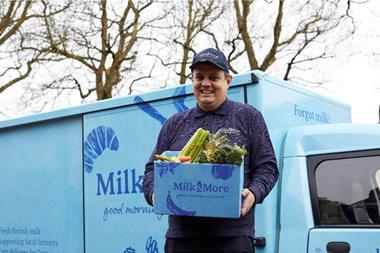Innovation, tiering and World Cup promotions have helped own-label pizza steal a lead on its rivals – but brands won’t give up their slice of the market without a fight, says Vince Bamford
Pizza proved a big hit with footie fans during the World Cup, but own-label products rather than brands lifted the trophy last year.
Combined sales of chilled and frozen pizza have risen 3.5% by value and 5.5% by volume driven by a 7.5% hike in value of own-label pizza, which now makes up 60.8% of the total market [Kantar Worldpanel 52w/e 28 November 2010]. Sales of brands, however, have slumped 2.1%.
Product innovation is behind much of the growth, with many retailers now offering products at multiple price and quality points.
"Over the past couple of years there has been an explosion of own-label development," attests Mel Bugler, brands division commercial director for Northern Foods. "Historically, own label tended to only be available in one tier, now it spans good, better and best tiering."
Pricing and promotions have also played a big role in the success of own label, with the average price of an own-label frozen pizza £1.22 compared with £1.51 for a branded one, he adds. "Own-label pricing is generally everyday low prices/long-term multibuy and is impacted by a high proportion being sold at £1."
With retailers stepping up their activity substantially across all price levels, consumers now have viable alternatives to branded options and they are voting with their wallets. "The choice offered by own-label ranges is bigger and gives shoppers the opportunity to pick and choose depending on their need," says Michael Keaveney, MD of Vion Pizza, which supplies own-label pizza to a number of supermarket chains. "And shopper loyalty to premium own-label has grown significantly," he adds.
When Sainsbury's relaunched its premium Taste the Difference tier last year it added two new pizzas to the line-up: butternut squash & feta and chargrilled vegetable. "The trend in 2010 was towards the night in 'treat', which has gone some way to replacing expensive meals out," says a Sainsbury's spokesman. "Premium pizzas have benefited from this, supported by NPD and improved quality."
But according to Paula Wyatt, marketing manager for frozen foods at Dr Oetker, there is another explanation for why overall sales of brands are trailing own label: the poor performance of Goodfella's, a rival to Dr Oetker's Chicago Town brand. Quoting IRI figures for 52 weeks ending 22 January, she says: "Goodfella's is down 16.5% year-on-year this is not a figure that is totally recoverable by other brands."
Even Goodfella's owner Northern Foods currently subject of a takeover bid by poultry tycoon Ranjit Boparan admits it has been a challenging year for the brand despite relaunching in April last year.
"We have been very open that the rebuild of Goodfella's will take time and it is far-fetched for others to talk of severe decline," says Northern's Bugler. "There is a new management team in place who have developed a robust plan to step change the fortunes of the brand, which they are currently sharing with retail customers. Our data shows that the Goodfella's brand is still a firm favourite in many UK households the new management team are working to ensure that it remains a key player in the UK category."
But whether shoppers are opting for a branded or an own-label frozen pizza, Kantar data shows they are more likely to have been buying thin & crispy products than deep pan. This has been prompted by interest in healthy eating and the perceived health benefits of eating a thin base that contains less dough, says Tesco.
It's a view supported by Northern Foods. "Thin has benefited from consumers seeking a lighter product and this sub-category has subsequently seen more innovation in recent years," says Bugler.
Deep pan is not the only format suffering. Other, relatively minor frozen formats have fared badly over the past 12 months, with sales of French bread pizza down 35.8% by value, and pizza slices down 73.6%.
"There has been little innovation in the baguette and slice market, so existing products have eroded in value and popularity," says Bugler. "New formats in the pizza category must have a very clear role and benefit, compared with other pizza products, for consumers to choose them."
Wyatt agrees that these sub-sectors have lacked innovation, and says another problem for frozen snacking products is that consumers have a wide variety of non-frozen snacks to choose from. "We think the frozen category does not appear as high on the consideration list," she says.
It's no coincidence that we have to look outside the freezer aisle for the star performer of the pizza market over the past 12 months chilled stonebaked pizzas, which have soared 27.1% by value year-on-year [Kantar]. The success of stonebaked has come at the expense of the larger chilled thin & crispy pizza sub-sector, which has lost 3.5% of value sales over the same period.
"Chilled pizza has done a good job of positioning itself as a posh alternative to frozen, and stonebaked rather than just thin is a good example of this," says Wyatt. "Consumers really expect the fresh/restaurant experience from chilled, and stonebaked is one way of delivering this."
Tesco included a selection of stonebaked pizzas in the line-up when it relaunched its pizza range last summer. "The range has performed well, with customers citing quality and strong promotional offers as key reasons they are buying into the range," says the spokesman.
Whether stonebaked or deep pan, pizzas performed particularly well last summer, scoring a big hit with footie fans during the World Cup.
And the brands were keen to make the most of it. Dr Oetker, for instance, unveiled the first in its ongoing series of limited-edition Takeaway products during the World Cup, in the shape of its meaty Footie Feast pizza.
"There was obviously a lot of excitement in-store around the World Cup, but to some extent frozen was looking like a bit of a poor relation compared with other categories," says Wyatt. "Retailers really got behind Footie Feast."
Retailers have also supported the category by offering pizzas as part of meal-deal promotions, with Pizza Express pizzas sold with a bottle of Coca-Cola and dough balls, for example. Such deals allow this heavily promoted category to encourage shoppers without devaluing the market.
"Tie-ups with other products help to build value and reward consumers with propositions that do not rely on price alone," says Northern's Bugler. "The challenge to the frozen pizza category is to provide consumers with promotional activity that isn't always price-focused."
For the brands, an additional challenge is giving consumers a reason to opt for their products rather than cheaper own-label items and NPD will play a major role in this.
Last year may well have gone to own-label, but brands will be looking to up their game and take back a slice of the pizza market in 2011.
Focus On Pizza
Pizza proved a big hit with footie fans during the World Cup, but own-label products rather than brands lifted the trophy last year.
Combined sales of chilled and frozen pizza have risen 3.5% by value and 5.5% by volume driven by a 7.5% hike in value of own-label pizza, which now makes up 60.8% of the total market [Kantar Worldpanel 52w/e 28 November 2010]. Sales of brands, however, have slumped 2.1%.
Product innovation is behind much of the growth, with many retailers now offering products at multiple price and quality points.
"Over the past couple of years there has been an explosion of own-label development," attests Mel Bugler, brands division commercial director for Northern Foods. "Historically, own label tended to only be available in one tier, now it spans good, better and best tiering."
Pricing and promotions have also played a big role in the success of own label, with the average price of an own-label frozen pizza £1.22 compared with £1.51 for a branded one, he adds. "Own-label pricing is generally everyday low prices/long-term multibuy and is impacted by a high proportion being sold at £1."
With retailers stepping up their activity substantially across all price levels, consumers now have viable alternatives to branded options and they are voting with their wallets. "The choice offered by own-label ranges is bigger and gives shoppers the opportunity to pick and choose depending on their need," says Michael Keaveney, MD of Vion Pizza, which supplies own-label pizza to a number of supermarket chains. "And shopper loyalty to premium own-label has grown significantly," he adds.
When Sainsbury's relaunched its premium Taste the Difference tier last year it added two new pizzas to the line-up: butternut squash & feta and chargrilled vegetable. "The trend in 2010 was towards the night in 'treat', which has gone some way to replacing expensive meals out," says a Sainsbury's spokesman. "Premium pizzas have benefited from this, supported by NPD and improved quality."
But according to Paula Wyatt, marketing manager for frozen foods at Dr Oetker, there is another explanation for why overall sales of brands are trailing own label: the poor performance of Goodfella's, a rival to Dr Oetker's Chicago Town brand. Quoting IRI figures for 52 weeks ending 22 January, she says: "Goodfella's is down 16.5% year-on-year this is not a figure that is totally recoverable by other brands."
Even Goodfella's owner Northern Foods currently subject of a takeover bid by poultry tycoon Ranjit Boparan admits it has been a challenging year for the brand despite relaunching in April last year.
"We have been very open that the rebuild of Goodfella's will take time and it is far-fetched for others to talk of severe decline," says Northern's Bugler. "There is a new management team in place who have developed a robust plan to step change the fortunes of the brand, which they are currently sharing with retail customers. Our data shows that the Goodfella's brand is still a firm favourite in many UK households the new management team are working to ensure that it remains a key player in the UK category."
But whether shoppers are opting for a branded or an own-label frozen pizza, Kantar data shows they are more likely to have been buying thin & crispy products than deep pan. This has been prompted by interest in healthy eating and the perceived health benefits of eating a thin base that contains less dough, says Tesco.
It's a view supported by Northern Foods. "Thin has benefited from consumers seeking a lighter product and this sub-category has subsequently seen more innovation in recent years," says Bugler.
Deep pan is not the only format suffering. Other, relatively minor frozen formats have fared badly over the past 12 months, with sales of French bread pizza down 35.8% by value, and pizza slices down 73.6%.
"There has been little innovation in the baguette and slice market, so existing products have eroded in value and popularity," says Bugler. "New formats in the pizza category must have a very clear role and benefit, compared with other pizza products, for consumers to choose them."
Wyatt agrees that these sub-sectors have lacked innovation, and says another problem for frozen snacking products is that consumers have a wide variety of non-frozen snacks to choose from. "We think the frozen category does not appear as high on the consideration list," she says.
It's no coincidence that we have to look outside the freezer aisle for the star performer of the pizza market over the past 12 months chilled stonebaked pizzas, which have soared 27.1% by value year-on-year [Kantar]. The success of stonebaked has come at the expense of the larger chilled thin & crispy pizza sub-sector, which has lost 3.5% of value sales over the same period.
"Chilled pizza has done a good job of positioning itself as a posh alternative to frozen, and stonebaked rather than just thin is a good example of this," says Wyatt. "Consumers really expect the fresh/restaurant experience from chilled, and stonebaked is one way of delivering this."
Tesco included a selection of stonebaked pizzas in the line-up when it relaunched its pizza range last summer. "The range has performed well, with customers citing quality and strong promotional offers as key reasons they are buying into the range," says the spokesman.
Whether stonebaked or deep pan, pizzas performed particularly well last summer, scoring a big hit with footie fans during the World Cup.
And the brands were keen to make the most of it. Dr Oetker, for instance, unveiled the first in its ongoing series of limited-edition Takeaway products during the World Cup, in the shape of its meaty Footie Feast pizza.
"There was obviously a lot of excitement in-store around the World Cup, but to some extent frozen was looking like a bit of a poor relation compared with other categories," says Wyatt. "Retailers really got behind Footie Feast."
Retailers have also supported the category by offering pizzas as part of meal-deal promotions, with Pizza Express pizzas sold with a bottle of Coca-Cola and dough balls, for example. Such deals allow this heavily promoted category to encourage shoppers without devaluing the market.
"Tie-ups with other products help to build value and reward consumers with propositions that do not rely on price alone," says Northern's Bugler. "The challenge to the frozen pizza category is to provide consumers with promotional activity that isn't always price-focused."
For the brands, an additional challenge is giving consumers a reason to opt for their products rather than cheaper own-label items and NPD will play a major role in this.
Last year may well have gone to own-label, but brands will be looking to up their game and take back a slice of the pizza market in 2011.
Focus On Pizza


















No comments yet